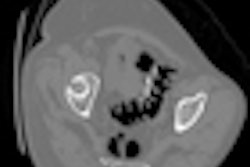Is the era of rapid growth in medical imaging procedure volume over? The volume of advanced imaging services delivered to Medicare beneficiaries decreased in 2009 -- the first decrease in 11 years, according to a study released Wednesday.
Washington, DC-based research and consulting firm the Moran Company found that the volume of advanced imaging services billed within the Medicare system decreased by 0.1% in 2009 compared with 2008, while overall imaging services declined by 7.1% for the same year-to-year comparison.
"It's pretty clear the era of very rapid growth in advanced medical imaging seems to have come to an end at this point in time," said Don Moran, president of the Moran Company. "All the data point to a leveling. It's unclear whether we will see further declines, but the prior growth of these modalities and the advantages they offer to clinicians seems to be peaking."
The study, released today by the Access to Medical Imaging Coalition (AMIC), reviewed Medicare claims data from 1999 through 2009, examining both spending and volume of advanced imaging services, such as CT, MRI, nuclear medicine, and PET, as well as overall imaging services, including mammography.
Declining volume
The analysis also found that the total volume of mammography screenings decreased by 0.3% in 2009, compared with a 2.8% compound annual growth rate in the past decade. In addition, the total volume of dual-energy x-ray absorptiometry (DEXA) exams fell by 2.2%, while spending on this technique decreased by 16% from 2008 to 2009.
The new findings are comparable to a 2008 analysis of Medicare claims data that showed a 19.2% reduction in Medicare spending on advanced imaging from 2006 to 2007. It also revealed a significantly reduced procedure volume growth rate of only 1.9%, which was less than the overall rate of physician-payment growth.
In addition, a study presented by David C. Levin, MD, and colleagues at the 2010 RSNA meeting found that imaging procedure volume grew at a compound annual growth rate (CAGR) of 1.4% between 2005 and 2008, well down from the 4.1% CAGR experienced between 1998 and 2005.
Imaging industry observers have attributed the slowing growth rate to reimbursement cuts for medical imaging such as those enacted by the Deficit Reduction Act of 2005. The healthcare reform legislation passed in 2010 includes additional reimbursement reductions.
The study shows that "medical imaging has been decimated by these cuts," said Tim Trysla, executive director of AMIC. "The impact of these cuts, even by the government's own estimates, has 'de facto' caused access problems for patients and providers. We are very concerned about choking off the access to these lifesaving technologies."
John Patti, MD, a radiologist at Massachusetts General Hospital in Boston and chair of the American College of Radiology Board of Chancellors, said he and fellow radiologists are concerned with imaging's declining growth rate, because the Medicare population is increasing and the incidence and prevalence of disease remain the same.
Early diagnosis
"One of the tremendous benefits of advanced imaging over the years is that it has obviated the need for more costly and evasive diagnostic evaluation," Patti said. "This reversal of trend suggests that Medicare patients may not be receiving those appropriate exams and thus the benefit of early diagnosis."
In addition, he said the decrease may have "negative downstream effects on the health of our aging citizens and on the cost of providing the more complex care that may be necessary to treat disease if it is discovered in advanced stages."
One potential victim of the decline is outpatient imaging center owners and operators. Because of reimbursement cuts for outpatient imaging, some physicians have sold or given their imaging activities to hospitals, which are reimbursed at a higher rate under the Hospital Outpatient Prospective Payment System (HOPPS). That scenario, in turn, could lead to less access to advanced imaging services.
In other study data, Medicare spending for advanced imaging services increased by less than half the spending growth for physician services overall. With a 1.2% increase in spending for advanced imaging, compared with 2.6% for services overall, imaging was one of the slowest-growing segments of the physician fee schedule in 2009.
Some optimism
Despite the volume downturn in 2009, Trysla believes that advanced medical imaging will continue to contribute to patient care. "Medicine will not turn its back on advanced technology, especially with the benefits of early detection of disease, such as Parkinson's disease and cancer," he said. "I think you will see growth through new applications in technology, and medicine will continue to evolve from exploratory surgery toward early and more exact detection."
ACR's Patti also speculated that the dip in growth in 2009 would be temporary. "I don't think there are any physicians who are taking direct care of patients who don't understand the value of advanced imaging," he added. "And, I don't think there are any physicians who are willingly withholding [advanced imaging] from patients."
By Wayne Forrest
AuntMinnie.com staff writer
February 9, 2011



















